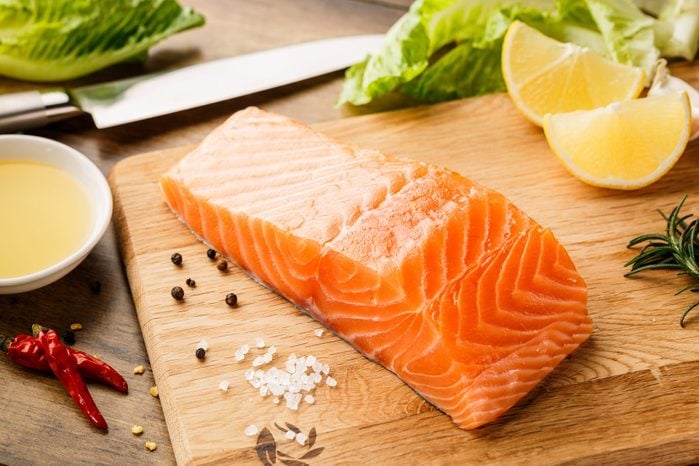Can You Eat Raw Salmon?

Can you eat raw salmon? Yes, but you may not want to…
Sushi lovers and serious foodies tend to be adventurous when it comes to seafood. Oily fish like salmon is a healthy option for just about everyone. It’s rich in protein and healthy fats, as well as vitamins like selenium. But what about raw salmon? Is it worth it? Let’s find out.
Can You Eat Raw Salmon?
Yes, salmon is a food that you can eat raw. However, it’s not safe for everyone, and there are some risks to consider first.
Raw salmon may contain bacteria, parasites and other types of pathogens or germs. The Food and Drug Administration (FDA) has listed salmon as a known source of parasites. Parasites are organisms that live on a live host (like a person) and get their food from the host.
Wild salmon caught near Alaska and Japan is at risk of carrying a type of tapeworm. This parasite lives in the small intestine and can grow to over 30 feet long! *shudder*
Raw salmon may also contain salmonella, shigella, E. coli, hepatitis A and norovirus.
Another risk to keep in mind has to do with environmental pollutants. Raw salmon may contain trace amounts of persistent organic pollutants (POPs), as well as heavy metals and other toxic chemicals. Exposure to POPs has been linked with an increased risk of cancer, birth defects and immune disorders.
Cooking salmon lowers most of these risks. Many foodborne illnesses are usually not an issue in cooked salmon because cooking the fish to 145°F (63°C) kills parasites and bacteria. Cooking salmon also lowers the levels of POPs by 26 percent.
Who Can’t Eat Raw Salmon?
Raw salmon isn’t for everyone. Consuming raw fish is more likely to cause serious foodborne illness in certain groups of people including pregnant women, children, older adults and those with weakened immune systems. Your immune system may be compromised if you have been diagnosed or treated for cancer, HIV, liver disease, diabetes or an organ transplant.
Here is a list of foods you should never eat raw.
How to Purchase Raw Salmon
Now that it’s time to buy salmon, there are a few tips to keep in mind. Most infections that came from eating seafood are related to the improper handling or storage of the fish. It may also be linked to eating fish that have lived in contaminated water.
Carefully inspect raw salmon before buying it. Make sure you don’t see any bruising or discoloration. If you notice a foul odor, skip it. Here’s a quick explainer about how to tell if salmon is bad.
When shopping, look for salmon that has been blast frozen at -31°F (-35°C). This process kills parasites (but not other pathogens).
Once you’re home from the store, place the salmon in the refrigerator right away. Always use clean plates and utensils when preparing it.
When it’s time to enjoy your raw salmon, give it another quick inspection. If you notice that your mouth, tongue or throat feels tingly while eating it, spit the fish out right away. The tingling could be a sign that the salmon contains a live parasite (ick).
If you’re a healthy adult and you don’t notice anything fishy about your meal, good-quality raw salmon may be your new favorite dish.



